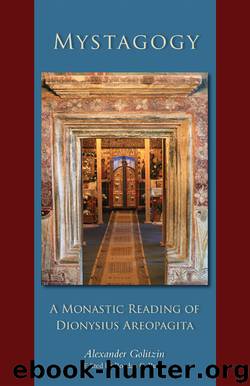Mystagogy: A Monastic Reading of Dionysius Areopagita (Cistercian Studies) by Alexander Golitzin

Author:Alexander Golitzin [Golitzin, Alexander]
Language: eng
Format: azw3
ISBN: 9780879077600
Publisher: Liturgical Press
Published: 2014-01-08T16:00:00+00:00
we witness an increasing drawing up and into the altar—and thus into the bishop who stands immediately before it—of all sacred virtue, activity, and knowledge. It is on the altar that the Scriptures, essence of our hierarchy, rest, from it that they are proclaimed, and on it again that the great sacraments of the Church, particularly the Eucharist, are accomplished: the representations of Christ’s “theurgy” which itself is the “recapitulation of all theology [i.e., Scripture].”271 Before the altar stands the bishop in whom the powers272 and science of the hierarchy are realized, and through whom all the lower clergy and laity participate in those same virtues and knowledge:273 “he effects [] the mysteries of our hierarchy through all the sacred orders.”274 It is on his head that the Scriptures are placed inasmuch as he is the recipient of all “perfecting power and science,”275 “the one who reveals the judgments of the Thearchy.”276 In view of the fact that he quotes him earlier in the CD,277 it seems likely Dionysius is saying with Ignatius of Antioch: “Where is the bishop, there is also Christ and his Church.”278
We would maintain that, under the guise of Neoplatonic vocabulary, this is exactly what he is saying. The bishop occupies the place of Christ “in whom every hierarchy is accomplished.”279 Reversing our perspective once again, we may see in the bishop standing before the altar the icon of the Thearchy, “the source of this hierarchy, the fount of life, the essence of goodness, the unique cause of being.”280 Through the bishop, the “threefold virtue” of the sacraments, like the primordial outpouring of the hidden God’s energies streaming into creation and extending from the angels to the last traces of being and even of non-being, pour out to penetrate the whole of the ecclesiastical polity, beginning with the priests and, in descending order together with diminishing éclat, extending to the deacons, the monks, the laity, and, most obscurely, to the orders of those not yet purified. Finally, it disperses and disappears from view in the night of ignorance and sin outside the doors. It is therefore no mere metaphor on Dionysius’ part when he speaks of the powers of the sacraments, flowing out from the bishop at the altar, as “the perfecting icons of the thearchic power,”281 or of the dispositions of our hierarchy as “icons of the divine energies.”282 The ecclesiastical hierarchy is the “hierarchic icon of the divine,”283 an active power and living participant in the divine archetype. The original outflowing of God’s energies into the darkness of non-being and then of creation is thus re-presented in the initial censing of the bishop whose tour of the Church is a realization of the activity of Providence that it typifies. It is the same energy of God working in and revealed in the bishop here, which established, preserves, and saves the worlds, and that now, “through this inspired and hierarchic harmony,” wills that “each participate, so far as he is capable, in him who is … Beautiful, Wise, and Good.
Download
This site does not store any files on its server. We only index and link to content provided by other sites. Please contact the content providers to delete copyright contents if any and email us, we'll remove relevant links or contents immediately.
| Clergy | Devotionals |
| Faith | Inspirational |
| Meditations | Monasticism & Asceticism |
| Prayer | Prayerbooks |
| Ritual | Sermons |
The Secret Power of Speaking God's Word by Joyce Meyer(2969)
More Language of Letting Go: 366 New Daily Meditations by Melody Beattie(2966)
The Holy Spirit by Billy Graham(2892)
To Light a Sacred Flame by Silver RavenWolf(2767)
Tuesdays With Morrie by Mitch Albom(2689)
The Lost Art of Good Conversation by Sakyong Mipham(2576)
The Traveler's Gift by Andy Andrews(2409)
Kundalini by Gopi Krishna(2136)
A Kingsbury Collection by Karen Kingsbury(2059)
Angels of God: The Bible, the Church and the Heavenly Hosts by Mike Aquilina(1932)
Finding Chika by Mitch Albom(1926)
Anxious for Nothing by Max Lucado(1910)
Angels by Billy Graham(1886)
As a Man Thinketh by James Allen(1861)
Curse Tablets and Binding Spells from the Ancient World by Gager John G.;(1837)
The Yoga of Jesus: Understanding the Hidden Teachings of the Gospels by Paramahansa Yogananda(1803)
Barking to the Choir by Gregory Boyle(1786)
Autobiography of a Yogi (Complete Edition) by Yogananda Paramahansa(1774)
How To Be Born Again by Billy Graham(1730)
